 Murder hates company. 
Rudolph Belarski, whose work is always instantly recognizable, painted this cover for Rufus King's 1944 mystery Never Walk Alone, earlier known as The Case of Dowager's Etchings. The change tells you that Popular Library thought a less old-fashioned title would boost sales for this 1951 re-issue. But the old-fashioned nature of the story is a feature, not a bug. What you get is intrigue at the residence of Carrie Giles, who's opened her large home up as a boarding house called River Rest and had the rooms filled by workers in an arms factory.
Giles is a throwback who's still driven around by horse and carriage in an era of cars and planes. The tale is told from her point of view, and never has a more self-contained observer been committed to the printed page. This derives from her belief in politeness and decorum. Even if you're a bit nosy, as she is, you don't make a fuss. When she finds a body on her grounds she simply leaves it there for someone else to stumble across the next afternoon. Maybe she's not such a throwback after all—we can see that happening even today, so she's an interesting figure created by King.
Her genteel nature is summed up in a passage about Humphrey Bogart. Don't forget that Bogart was a famous film villain before he altered the trajectory of his career. Giles knows only the early Bogart, and is horrified when someone compares one of her boarders to Humphrey: Mrs. Giles shut her eyes. She was fairly familiar with Mr. Bogart's characterizations on the screen, and to have any one of those blood-throttling roles in the house was the last straw.
Can a mystery be fun when told from the point of view of a hidebound busybody? Turns out it can. While other elements of the story are interesting too (she thinks the murder has to do with wartime spies, and particularly suspects an outspoken and modern-minded female guest), Mrs. Giles is ultimately such a fascinating and delicate creation that it was her who kept us turning pages. Never Walk Alone isn't for readers seeking fireworks and sexual intrigue, but as an example of a character-driven mystery, it worked fine.
 Looks like we're dead meat. You know what I want my gravestone to say? “Just like always it was my stupid brother's fault.” 
Author Max Brand, née Frederick Faust, was incredibly prolific for a guy who died early. He produced numerous stories and around a hundred fifty novels, including the source material for film and television's Dr. Kildare, and the 1956 western Brothers on the Trail, which you see here with Robert Stanley cover art. Brand was killed in 1944 at age fifty-one while working as a war correspondent in Italy, but he left quite a literary legacy.
 She must be more of a coffee person. 
This cover for The Bitter Tea of General Yen, which was came in 1949 from Popular Library, could have been painted by Rudolph Belarski. It's funny we're guessing, because we just said his art is instantly recognizable. Oh well. Usually he managed to place his signature where it wasn't easily covered by publishers, but not always. He was collaborating with Popular Library a lot during this period, and it looks like his work, but without his signature we can't say it's him—or really anyone else. But while the cover is officially by an unknown, it does fit into our collection of women being toted hither and yon on mid-century paperbacks. You can see those here. The novel was first published long before the paperback—way back in 1931. The story is set in China, and follows Megan Davis, who has traveled there during a time of civil war to marry a medical missionary. Turbulent circumstances lead to her being assaulted by a crowd and presumed dead. But she's actually rescued and placed under the protection of the anti-communist General Yen Tso-Chong of the book's title. The general plans to take the utmost care of Megan because her safe return will be a propaganda coup. But while in his villa he and Megan discuss their different cultures, religions, politics, and views of current events:
“In capturing the city of Nanking the troops of General Chen Chien got a little out of hand. War, you know, does not bring out the best qualities of tolerance and self-control; that is one reason why we Chinese are so unfitted for it.”
“But what was the incident?”
“A number of people were shot and some were killed, missionaries largely, Doctor Williams of the Nanking College, some ladies, the British Consul too, I believe.”
“Shot by Chinese?”
“By troops, yes.”
“But that is an outrage!” cried Megan, overwhelmed with anger. “We are not at war with you!”
“No? Well, at any rate your gunboats, in retaliation, fired on the unarmed, civilian population of Nanking, killing hundreds. But after all, why should you and I talk about it?”
“I don’t believe they fired on the civilian population, or if they did, they must have been forced into it.”
The General shrugged his shoulders.
That's a very appropriate exchange for our current times, but Megan and Yen's verbal jousting is interesting only to a point. In the end Zaring Stone is restrained enough to leave the politics unresolved, and brings the book to perhaps the only conclusion that fits. Now that you know the plot, you may be pondering the cover and asking yourself, "Who's the studly Anglo carrying the damsel in distress?" He doesn't exist in the narrative. It's General Yen who saves Megan. But Popular Library, we suppose, didn't want a Chinese man to star in that role on newsstands. Welcome to 1949.
In any case, Hollywood liked the 1931 hardback enough to adapt it into a 1933 film directed by Frank Capra, with the always amazing Barbara Stanwyck in the lead. We'd normally be leery of any movie made during that time depicting Chinese people (the title role is played by Danish actor Nils Asther), but you gotta give Stanwyck and Capra a shot, right? Like, it'd be neglectful of any cinephile not to watch it. So we'll let you know when/if we circle back to it.

 You heard me. Census taker, liver, a nice chianti, fava beans. Having guests for dinner has long been a passion of mine. 
Rudolph Belarski is a top notch illustrator and his art is always immediately recognizable. We knew this was him without having to check (then we checked to be sure). Yup. It's him. To see more nice examples of his work look here, here, and here. Leo Brady's 1949 novel Edge of Doom isn't about eating anyone for dinner, though that would be fun. It's about murdering a priest, and was made into a 1950 film with Farley Granger as the disturbed man at the crux of the tale. Perhaps we'll get around to watching it down the line.
 If you jump without looking you might get swept away. 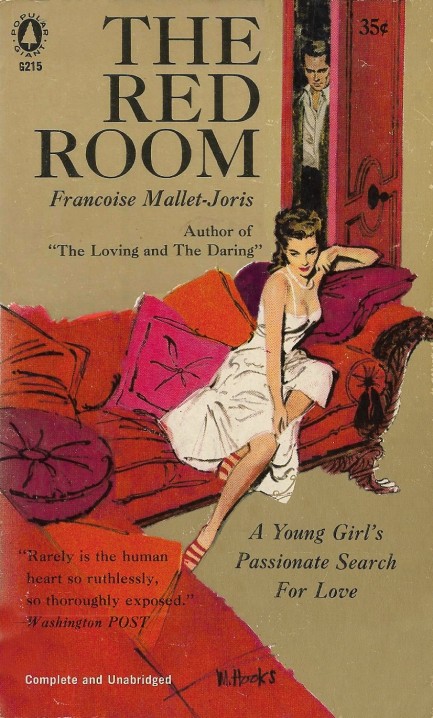
The book you see above, a 1958 Popular Library edition of The Red Room by Belgian author Françoise Mallet-Joris, was picked up for us by a friend who thought he was buying a pulp novel. He was attracted by the cover, and it's indeed fine work, from the skilled brush (and possibly ink quill and charcoal pencil) of Mitchell Hooks. As for the novel, it was originally published in 1955 as La chambre rouge and was a sequel to 1951's Le rempart des Béguines.
When someone buys us a book we always read it out of appreciation and respect, even romance novels, and in reading The Red Room we were reminded once again of the skill gap between literary and crime fiction. There are obviously excellent, transcendent crime writers (and literary fiction that misses the mark), but Mallet-Joris—even translated—spins evocative phrases as deftly as a weaver with a loom. Like this one:
The presence of winter—vulgar winter, befurred and jangling her crystal adornments—was scarcely felt in the small white and gold drawing room.
Isn't that nice? It's not Hammett describing a gangster popping off shots in a crowded bar, but it's still fun to read. The tale is a coming of age breast-beater set in Gers, France in which the main character, eighteen-year-old Hélène Noris decides to steal the dashing young film director her hated stepmother Tamara has earmarked for extra-marital games. That actually sounds kind of pulp, doesn't it? Well, just wait.
At some point it becomes clear that Hélène had been Tamara's young lover (probably this is the central plot of the previous book). Tamara and Hélène had been carrying on, but in order to secure for herself a stable existence Tamara decided to marry Hélène's father. Thus, The Red Room charts Hélène as she impulsively steals her stepmother's crush, only to find herself getting in too deep with someone who's more experienced and decisive than any man she's known.
Needless to say, that plot sounds like some of the sleaze novels we highlight here, which would make you wonder, in terms of public perception, at which point the lowbrow becomes highbrow. And the easy answer to that is: when you can write like Mallet-Joris. Overall, The Red Room is probably a little too genteel and interiorized for most pulp readers, but we liked it. Consider that less a recommendation than an acknowledgment of talent.
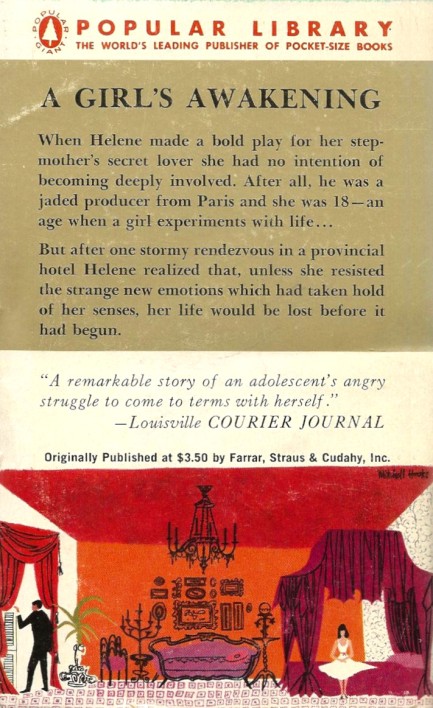 
 I did it the same way you became a boy reporter, but with less respect and more talent. 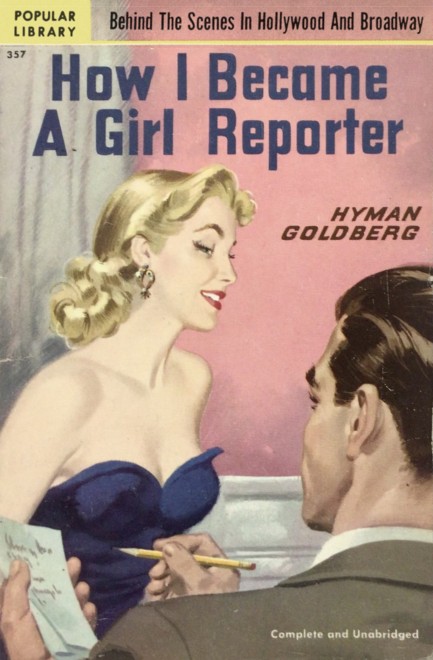
How I Became a Girl Reporter was first published in 1951, and as the title and cover indicate, Hyman Goldberg's novel is a breezy little number about men and women who have various workplace encounters that presage romance. The book was well received, and while we were tempted to buy it to learn just how different the co-ed workplace was back then (as if we couldn't guess), venturing anywhere near the boundaries of comedy is a dodgy proposition when you're talking about this time period. Maybe we'll read it down the line. The cover art is by an unknown.
 I came to the bar to have a double—and look. They're about to come over here now. 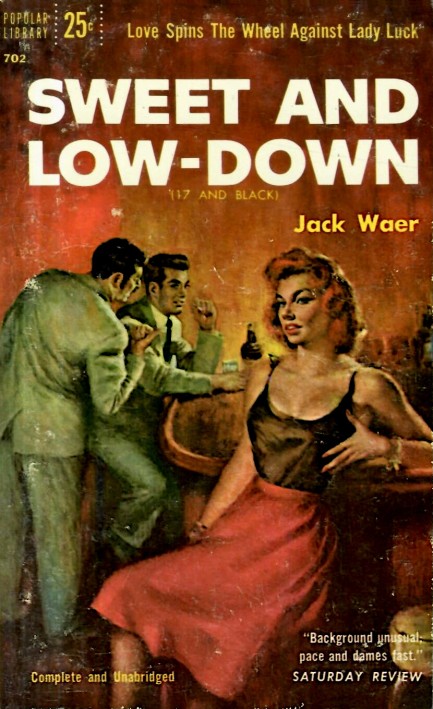
1955's Sweet and Low-Down was originally published as 17 and Black in 1954. The copy we bought is very worn. We looked for a better scan online to use, as we'll sometimes do, but every example we saw was equally abraded until we found one on Amazon, which you see above. It's a pretty nice cover, though uncredited. Is all the wear and tear on copies of this book an indication that it's read and re-read often, and therefore is good? That's certainly what we hoped.
The story, written by Polish born author Alexander Warchiwker writing as Jack Waer, is about Jim Foster, who runs an illegal casino in Hollywood but flees south of the border after taking a rap for his partners. They later ask him to open another casino in Mexico City. He's willing to oblige—for a bigger percentage—but during the opening gala the murder of a local one percenter spoils the party. It's an intriguing set-up for a novel, although it starts slowly. Luckily Waer's writing style maintains interest. For example:
The first time I called, the bim with the sultry voice let on she didn't have any idea who I wanted—said I had the wrong number. When I dialed back her memory was better. His nibs came to the phone. I found out that the vicers were off on a fresh trail. They were out for a pair of Internal Revs who were suspected of collecting a split from the top wigs in the commie crowd. I was as stale as a warmed over soufflé.
Strong approach there. A book this slang heavy goes in for a lot of off-color language, unsurprisingly, and being set in Mexico means there's racist invective. We could not in any way blame you for deciding to take a pass. There are plenty of vintage crime novels that visit Mexico without donning a Klan hood. We're not put off by a smidgen of salty language, but there's a limit—we don't think Foster ever used a non-slur to refer to a Mexican character, even when speaking of his so-called friends.
In any case, he needs to solve the murder, and he does precisely that, and solves another couple of mysteries too. Much of the book takes place within the casino, which would be fine if Waer managed to keep the stew at a hard boil, but his narrative cools considerably toward the finale, and the story drags. The end makes clear that the book was supposed to be a launching point for more novels, and the fact that it wasn't says everything you need to know. But if you find it cheap and don't mind the language, sure, what the hell, give it a read.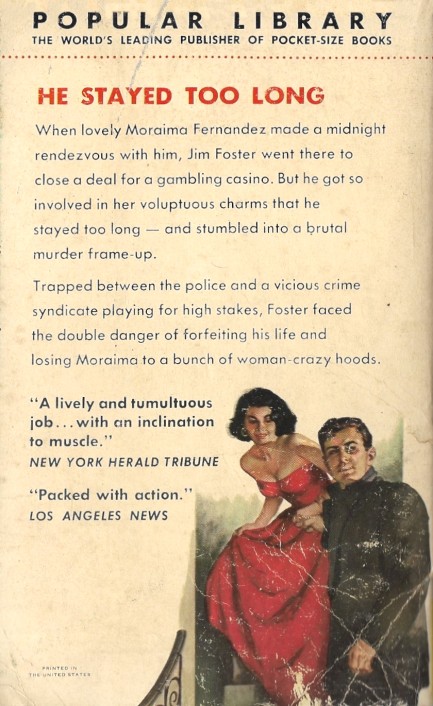
 Me? Why should I touch it? You’re the one always going on about how you can tell everything about a man from his handshake. 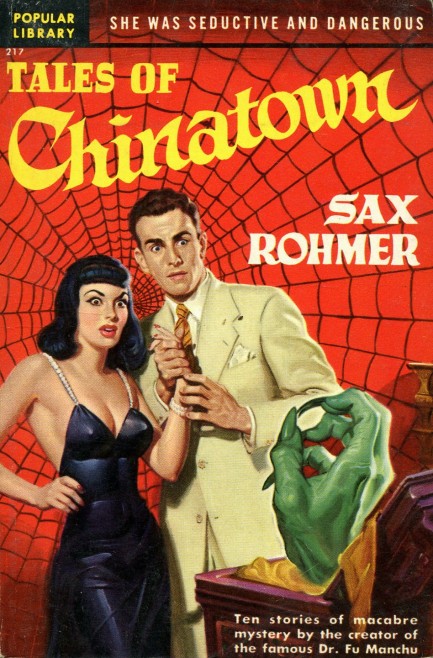
British author Sax Rohmer, aka Arthur Henry Ward, wrote many novels but made his reputation with the Fu Manchu series. Tales of Chinatown doesn’t feature that famous character, but instead deals in short story form with other characters and various unsavory goings-on in the Chinese underworld of London’s Limehouse district. There are problems with Rohmer’s depictions of Chinese, Jews, and other groups, but the writing is more than a century old, so no surprise there.
In terms of execution, there’s a sinister mood of a type here that's quite effective. "The Daughter of Huang Chow," the opening tale, deals with a series of fatal poisonings among the Limehouse criminal set, and the mysterious contents of an ornamental coffin. "The Hand of the Mandarin Quong," from which the cover is derived, is set in Singapore and London, and tells the story of a man who loses a hand in a failed attempt to rescue his kidnapped wife, but whose severed body part continues to haunt and hunt the kidnapper.
Tales of Chinatown is an atmospheric collection, well written and imaginatively conceived. It's easy to see why Rohmer became an international sensation. Many of his tropes are by now familiar if not hackneyed (and his racialized musings are deservingly excoriated), but back when his ideas were fresh they must have given his readers the megacreeps. Crime, suspense, mystery, mysticism, horror—Tales of Chinatown has all that. It first appeared in 1922, and this Popular Library edition with art by Rudolph Belarski is from 1949.
 Temperatures rise and tempers fray in Ard thriller. 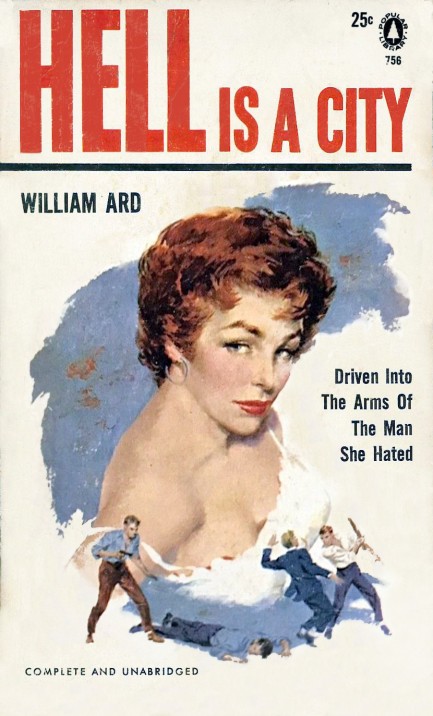
We've been searching for everything we can find by William Ard because his books have been consistently good. This Popular Library edition of 1955's Hell Is a City has George Mayers cover art. We dove right into it, and the narrative (which is unrelated to the movie of the same name) focuses again on Ard's NYC private investigator Timothy Dane, who this time tries to prove that a slam-dunk murder charge is a frame put together by a predatory cop.
Ard reveals this in chapter one, when young Jamie Colyero, barely more than a boy, shoots the cop who tries to rape his sister Rita. The cop had been after her for weeks, and finally plants heroin on Jamie, engineers an arrest, then tells Rita the charges can possibly dropped if she meets him at a hotel and gives up her goodies. Out of desperation to help her brother, she agrees.
Unbeknownst to her, she's followed to the hotel by her brother, who's out on bail, and Jamie kicks in the door and ruins the cop's plan—lethally. Dane is in the picture shortly thereafter, working for a newspaper editor who wants to expose the lies of a rival sheet that has used its pages to turn the dirty cop into a saint. All of this will swing the next mayoral election, so the stakes are as high as can be.
Long story short, the book is great. Like other Ard tales it moves exceedingly fast for a piece of vintage fiction, racing through numerous twists and scrapes, with intermittent bursts of action, until it reaches a conclusion that shakes the city to its foundations and leaves readers satisfied. If you enjoy 1950s crime novels, read anything by Ard. You won't regret it.
 Oh, hey. Um, I guess it's probably better to hear this from your best friend. Your wife has been cheating on you. 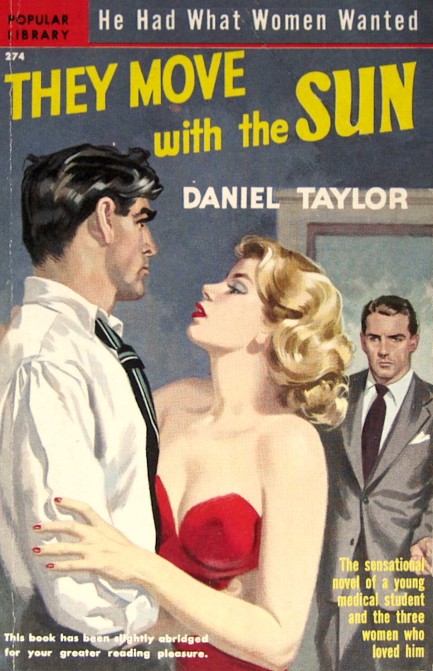
Above: Daniel Taylor's They Move with the Sun, from 1948 originally, with this Popular Library edition coming in 1952. The cover art is uncredited, but it fits nicely with our collection of cheaters caught together, which you can see here.

|
 |

The headlines that mattered yesteryear.
2003—Hope Dies
Film legend Bob Hope dies of pneumonia two months after celebrating his 100th birthday. 1945—Churchill Given the Sack
In spite of admiring Winston Churchill as a great wartime leader, Britons elect
Clement Attlee the nation's new prime minister in a sweeping victory for the Labour Party over the Conservatives. 1952—Evita Peron Dies
Eva Duarte de Peron, aka Evita, wife of the president of the Argentine Republic, dies from cancer at age 33. Evita had brought the working classes into a position of political power never witnessed before, but was hated by the nation's powerful military class. She is lain to rest in Milan, Italy in a secret grave under a nun's name, but is eventually returned to Argentina for reburial beside her husband in 1974. 1943—Mussolini Calls It Quits
Italian dictator Benito Mussolini steps down as head of the armed forces and the government. It soon becomes clear that Il Duce did not relinquish power voluntarily, but was forced to resign after former Fascist colleagues turned against him. He is later installed by Germany as leader of the Italian Social Republic in the north of the country, but is killed by partisans in 1945.
|

|
|

It's easy. We have an uploader that makes it a snap. Use it to submit your art, text, header, and subhead. Your post can be funny, serious, or anything in between, as long as it's vintage pulp. You'll get a byline and experience the fleeting pride of free authorship. We'll edit your post for typos, but the rest is up to you. Click here to give us your best shot.

|
|





























































































